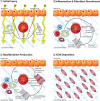Radiation-induced fibrosis: mechanisms and implications for therapy
- PMID: 25910988
- PMCID: PMC4573901
- DOI: 10.1007/s00432-015-1974-6
Radiation-induced fibrosis: mechanisms and implications for therapy
Abstract
Purpose: Radiation-induced fibrosis (RIF) is a long-term side effect of external beam radiation therapy for the treatment of cancer. It results in a multitude of symptoms that significantly impact quality of life. Understanding the mechanisms of RIF-induced changes is essential to developing effective strategies to prevent long-term disability and discomfort following radiation therapy. In this review, we describe the current understanding of the etiology, clinical presentation, pathogenesis, treatment, and directions of future therapy for this condition.
Methods: A literature review of publications describing mechanisms or treatments of RIF was performed. Specific databases utilized included PubMed and clinicaltrials.gov, using keywords "Radiation-Induced Fibrosis," "Radiotherapy Complications," "Fibrosis Therapy," and other closely related terms.
Results: RIF is the result of a misguided wound healing response. In addition to causing direct DNA damage, ionizing radiation generates reactive oxygen and nitrogen species that lead to localized inflammation. This inflammatory process ultimately evolves into a fibrotic one characterized by increased collagen deposition, poor vascularity, and scarring. Tumor growth factor beta serves as the primary mediator in this response along with a host of other cytokines and growth factors. Current therapies have largely been directed toward these molecular targets and their associated signaling pathways.
Conclusion: Although RIF is widely prevalent among patients undergoing radiation therapy and significantly impacts quality of life, there is still much to learn about its pathogenesis and mechanisms. Current treatments have stemmed from this understanding, and it is anticipated that further elucidation will be essential for the development of more effective therapies.
Keywords: Cancer; Fibroblast; Fibrosis; Inflammation; Radiation; TGF-β; Therapy.
Conflict of interest statement
The authors declare that they have no conflict of interest.
Figures

References
-
- Abratt RP, Morgan GW, Silvestri G, Willcox P (2004) Pulmonary complications of radiation therapy. Clin Chest Med 25:167–177. doi:10.1016/s0272-5231(03)00126-6 - PubMed
-
- Abreu MT, Fukata M, Arditi M (2005) TLR signaling in the gut in health and disease. J Immunol 174:4453–4460 - PubMed
-
- Andreassen CN et al (2006) ATM sequence variants and risk of radiation-induced subcutaneous fibrosis after postmastectomy radiotherapy. Int J Radiat Oncol Biol Phys 64:776–783. doi:10.1016/j.ijrobp.2005.09.014 - PubMed
Publication types
MeSH terms
Substances
Grants and funding
LinkOut - more resources
Full Text Sources
Other Literature Sources
Medical
Molecular Biology Databases

